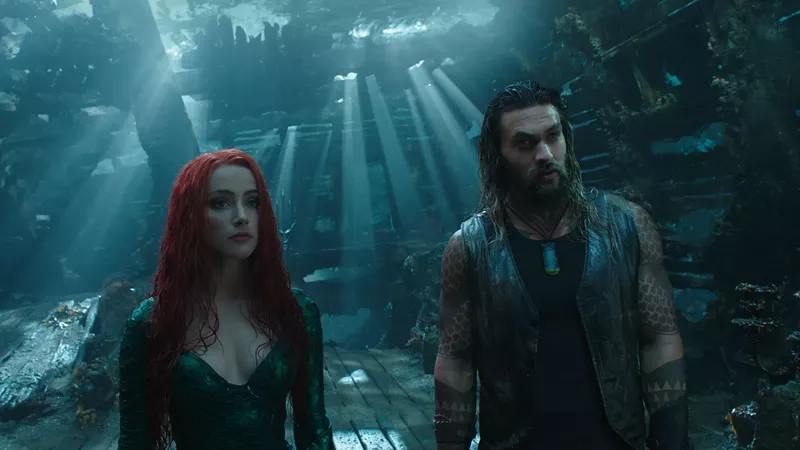The tagline for Richard Donner’s original Superman (1978) — “You’ll believe a man can fly” — wasn’t just a boast about breakthrough special effects. It was a promise of wonder — that you’d not just behold a pairing of the human and the impossible, but that you’d be moved by it, that it would be a joy rather than a chore to suspend your disbelief.
Wonder has often been in short supply in the never-ending age of superhero movies. This month, though, it’s suddenly in abundance. First came that soaring, remix-minded hit Spider-Man: Into the Spider-Verse, an inquiry into the humanity of spider-folk that’s, no joke, one of the best movies of the year. And now, just a week later, James Wan’s giddy epic Aquaman cannonballs into the pool, making a much greater splash than you might have expected. Its star, the beard-scraggled man-mountain Jason Momoa, tends to burp out his dialogue with a little uncertainty, so the film is no triumph of humanism. But it has seven seas’ worth of the simpler kind of wonder, the razzle-dazzle imaginative kind. Here are the warriors of Atlantis straddling great white sharks and swimming into battle. Here’s an ancient combat arena deep in the Atlantic where combatants face off above pulsing lava and a martial drumbeat is pounded out by (double-checks notes for confirmation) a giant octopus. Here are sea beasts straight from Homer and Lovecraft, a Tron Atlantis and an Attack of the Clones-style clash against an army of crustaceans.
I’m not saying you’ll emerge from this extravaganza believing that a man can talk to fish, but I will promise this: If anything in that description sounds at all appealing to you, you probably won’t regret the plunge. And in their own mumbly way, Momoa and this Aquaman did in the end even move me, some, through the power of representation and metaphor. Our hero is a hard-drinking surface-dweller townie raised in a Massachusetts lighthouse and named, for some reason, Arthur Curry. Arthur also happens to be a princeling with a claim to the throne of Atlantis. (His dad, played by Temuera Morrison, fell in love with Nicole Kidman’s reluctant mer-princess Atlanta.) Aquaman’s half-brother, the current king (Patrick Wilson), plans war upon us polluting landlubbers, sick of our oil spills and chucked-out beer cans. After Atlantis takes a spectacular first strike, Aquaman — at the urging of the Atlantean battle-mermaid Mera (Amber Heard) — sets out to claim his crown and usher in an age of peace between the realms. As Mera puts it, this man of two worlds is “the bridge between land and sea.”
That’s hilarious, sure. A bridge leading from land to sea is actually a ramp. But that artlessness allows for a more pressing meaning: A bridge between two cultures in conflict beats the hell out of a wall. Not incidental to Aquaman’s pleasures is its vision of a mixed-race hero, played by a mixed-race actor, fighting to protect and understand clashing aspects of his heritage. This drumming-octopus goof of a movie chums its waters with boldly bonkers battles that suggest a briny Return of the King, the oddest of old Saturday morning cartoons, and even the covers of ’70s horror paperbacks. But it also can’t help glancing up against meaning — though, to its credit, it never slows down to dwell on such matters. There’s always another kraken to ride!
The key is Wan. With his horror films, like The Conjuring and Saw, he evinced a skill for rare manipulative clarity. Unlike so many of his contemporaries, whose sequences flail somewhat recklessly from beat to beat, Wan has always nudged audiences to feel exactly what he wants us to, just when it suits him, while situating us precisely within the action. Recall how the roving camera from The Conjuring stirred the sense that we weren’t just watching characters wander that house; we, too, seemed to be exploring. With Furious 7, he applied that talent for you-are-there immersiveness with that franchise’s hurtling momentum and WWE-style featured brawls. The fit was perfect, the action not just joyously ludicrous but coherent. Now he’s working on his largest scale yet, and he proves himself adept at a wide variety of fantasy adventure sequences. I loved the protracted Mediterranean rooftop chase and face-offs, which marry the vaulting glee of Steven Spielberg’s The Adventures of Tintin with the travelogue grit of the Jason Bourne and recent James Bond films. That comes just a couple of scenes after a mostly animated (and entirely convincing) doozy depicting underwater gladiator combat and a zipping sub chase that beats Ron Howard’s Solo at Han Solo-isms. Aquaman also boasts showcase set pieces from disaster epics, Clash of the Titans-style mortal-vs.-gods silliness, and a hold-your-breath terror pairing World War Z with The Abyss.
That said, Wan is no master of tone. The film bucks recklessly from mood to mood and shovels in backstory at awkward junctures — and even with that it’s hard to get much of a read on just who Momoa’s Aquaman was before he started on this adventure. The biggest buzzkill is the most earthbound sequence. Aquaman is the third PG-13 film I’ve seen this year to feature a scene of badass villains bursting into a command center and machine-gunning innocents at their workstations. Kids are going to steep themselves in this movie, watching it over and over. I don’t worry that it’s going to inspire them to ride seahorses to war, as thoroughbred seahorses aren’t readily available to them. But in this deeply troubled country, guns are available, and Aquaman (like Skyscraper and Mortal Engines before it) depicts those guns as the quickest, easiest way to prove you’re somebody who deserves our attention. We may no longer believe a man can fly, but we know damn well a kid can shoot.

Audio By Carbonatix
[
{
"name": "GPT - Billboard - Slot Inline - Content - Labeled - No Desktop",
"component": "23668565",
"insertPoint": "2",
"requiredCountToDisplay": "2"
},{
"name": "STN Player - Float - Mobile Only ",
"component": "23853568",
"insertPoint": "2",
"requiredCountToDisplay": "2"
},{
"name": "Editor Picks",
"component": "17242653",
"insertPoint": "4",
"requiredCountToDisplay": "1"
},{
"name": "Inline Links",
"component": "18838239",
"insertPoint": "8th",
"startingPoint": 8,
"requiredCountToDisplay": "7",
"maxInsertions": 25
},{
"name": "GPT - 2x Rectangles Desktop, Tower on Mobile - Labeled",
"component": "24956856",
"insertPoint": "8th",
"startingPoint": 8,
"requiredCountToDisplay": "7",
"maxInsertions": 25
},{
"name": "Inline Links",
"component": "18838239",
"insertPoint": "8th",
"startingPoint": 12,
"requiredCountToDisplay": "11",
"maxInsertions": 25
},{
"name": "GPT - Leaderboard to Tower - Slot Auto-select - Labeled",
"component": "17676724",
"insertPoint": "8th",
"startingPoint": 12,
"requiredCountToDisplay": "11",
"maxInsertions": 25
}
]








